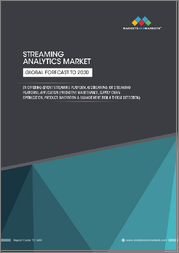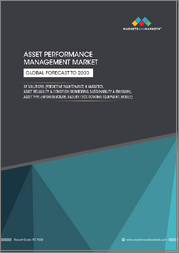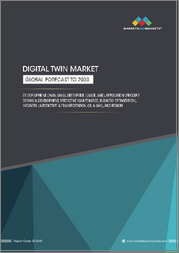
|
시장보고서
상품코드
1438232
진동 상태 모니터링 서비스 시장 예측(-2030년) : 구성요소별, 모니터링 프로세스별, 최종사용자별, 지역별 세계 분석Vibration Condition Monitoring Services Market Forecasts to 2030 - Global Analysis By Component (Hardware, Software and Services), Monitoring Process (Online Monitoring, Portable Monitoring and Wireless Monitoring), End User and By Geography |
||||||
Stratistics MRC에 따르면, 세계 진동 상태 모니터링 서비스 시장은 예측 기간 동안 CAGR 6.8%로 성장할 것으로 예상됩니다.
진동 상태 모니터링 서비스는 기계 및 장비의 진동 신호를 체계적으로 측정, 분석 및 해석하여 건전성과 성능을 평가하는 서비스입니다. 이러한 서비스는 제조, 발전, 석유 및 가스, 운송, 항공우주 등 기계 가동 중단이 큰 금전적 손실로 이어질 수 있는 산업에서 매우 중요합니다. 이러한 서비스는 산업 기계 및 장비의 신뢰성, 안전성, 효율성을 보장하는 데 중요한 역할을 하며, 궁극적으로 기업의 비용 절감과 업무 생산성 향상에 기여합니다.
예측보존의 중요성이 증가
예지보전은 장비 고장 및 사고의 위험을 줄여 보다 안전한 작업 환경을 조성하는 데 기여합니다. 진동 수준을 모니터링하고 이상을 감지함으로써 기업은 잠재적인 안전 위험을 식별하고 사고가 발생하기 전에 시정 조치를 취하여 직원과 자산을 모두 보호할 수 있습니다. 또한, 예지보전을 채택한 기업은 비용 절감, 신뢰성 향상, 생산성 향상으로 경쟁 우위를 확보할 수 있습니다. 이는 시장 수요를 가속화할 것입니다.
높은 초기 투자
진동 모니터링 시스템을 도입하려면 하드웨어, 소프트웨어 및 교육에 많은 자본 투자가 필요합니다. 이 비용은 특히 예산이 한정된 중소기업(SME)에게는 엄청난 비용이 될 수 있습니다. 또한, 데이터 분석, 센서 설치, 시스템 통합 등의 전문 지식이 필요하기 때문에 초기 비용이 더 많이 듭니다. 높은 초기 투자비용은 도입 장벽으로 작용하여 도입률을 떨어뜨리고 진동 상태 모니터링 서비스의 보급을 저해하고 있습니다.
IIoT와 빅데이터 분석 도입 증가
IIoT 지원 센서는 기계에서 방대한 양의 데이터를 수집하여 장비의 상태와 성능에 대한 실시간 인사이트를 제공합니다. 빅데이터 분석은 이 데이터를 처리하여 패턴, 추세, 이상 징후를 감지하고 예지보전 전략을 가능하게 하며, IIoT와 빅데이터 분석을 활용하여 진동 상태 모니터링 서비스는 보다 정확하고 사전 예방적인 모니터링 솔루션을 제공하여 자산의 신뢰성을 최적화하고 다운타임을 최소화하여 다양한 산업 분야에서 운영 효율성을 높일 수 있습니다. 가동 중지 시간을 최소화하고 다양한 분야의 산업에서 운영 효율성을 높일 수 있습니다. 이러한 요인들이 시장 확대에 기여하고 있습니다.
기술적 과제
모니터링 시스템을 기존 인프라와 통합하는 것은 특히 다양한 장비 유형과 레거시 시스템을 보유한 산업에서 복잡하고 비용이 많이 들 수 있습니다. 호환성 문제, 상호운용성 문제, 데이터 분석 및 시스템 통합에 대한 전문 지식의 필요성 등이 도입에 걸림돌이 될 수 있습니다. 또한, 기술의 급속한 발전으로 인해 모니터링 솔루션의 지속적인 업그레이드와 업데이트가 필요하게 되어 복잡성이 더욱 증가하게 됩니다.
COVID-19의 영향
COVID-19 사태는 처음에는 산업 활동의 감소와 유지보수 지출의 연기로 인해 진동 상태 모니터링 서비스 시장의 침체를 초래했습니다. 그러나 기업들이 원격 운영에 적응하고 비용 효율적인 유지보수 솔루션을 찾으면서 진동 모니터링을 포함한 예지보전의 중요성이 부각되고 있습니다. 이에 따라 산업계가 자산의 신뢰성과 운영 효율성을 우선시하게 되면서 수요가 점차 회복되고 있습니다. 팬데믹으로 인해 예방적 유지보수 전략의 중요성이 부각되었고, 지속적인 경제적 어려움에도 불구하고 진동 상태 모니터링 서비스에 대한 관심이 다시 한 번 높아졌습니다.
예측 기간 동안 하드웨어 부문이 가장 큰 비중을 차지할 것으로 예상
하드웨어 부문이 가장 큰 점유율을 차지할 것으로 추정됩니다. 하드웨어 부문은 센서, 가속도계, 트랜스듀서, 데이터 수집 장치, 모니터링 시스템으로 구성됩니다. 이러한 하드웨어 구성요소는 진동 수준, 주파수 및 패턴을 측정하기 위해 기계 및 장비에 장착됩니다. 이러한 센서에 의해 수집된 데이터는 이상 감지, 잠재적 고장 식별, 장비 고장 예측을 위해 분석됩니다. 또한, 하드웨어 솔루션은 실시간 모니터링, 데이터 수집 및 분석을 가능하게 하여 다양한 산업 분야에서 자산의 신뢰성과 운영 효율성을 최적화하기 위한 사전 예방적 유지보수 전략을 촉진하는 데 중요한 역할을 합니다.
예측 기간 동안 석유 및 가스 분야가 가장 높은 CAGR을 기록할 것으로 예상
석유 및 가스 분야는 예측 기간 동안 유리한 성장세를 보일 것으로 예상됩니다. 이 분야는 탐사, 시추, 정제 공정에 사용되는 펌프, 압축기, 터빈과 같은 중요한 장비의 진동을 모니터링합니다. 센서와 데이터 분석을 활용하여 베어링 마모, 로터 불균형 등 잠재적인 고장을 나타내는 이상 징후를 감지합니다. 진동 수준과 진동 패턴을 지속적으로 모니터링하여 베어링 마모, 정렬 불량, 로터 불균형과 같은 잠재적 고장을 조기에 식별하여 적시에 유지보수 개입을 할 수 있도록 합니다. 이러한 사전 예방적 접근 방식은 비용이 많이 드는 다운타임을 방지하고 운영 효율성을 높이며 석유 및 가스 인프라와 생산 공정의 안전과 신뢰성을 보장하는 데 도움이 됩니다.
가장 큰 점유율을 차지하는 지역
추정 기간 동안 아시아태평양이 가장 큰 시장 점유율을 차지했습니다. 아시아태평양은 진동 상태 모니터링 서비스의 가장 빠르게 성장하는 시장 중 하나입니다. 중국, 인도, 일본, 한국, 동남아시아 국가 등의 급속한 산업화로 인해 운영 효율성을 보장하고 가동 중단 시간을 최소화하기 위한 기계 상태 모니터링 솔루션에 대한 수요가 증가하고 있습니다. 또한, APAC 지역은 IoT 센서, 클라우드 기반 모니터링 플랫폼 및 고급 분석의 통합을 포함한 진동 모니터링 기술의 급속한 발전을 목격하고 있습니다.
CAGR이 가장 높은 지역:
북미 지역은 예측 기간 동안 수익성 높은 성장을 보일 것으로 예상됩니다. 이 지역에는 진동 모니터링 기술의 선도적인 공급업체와 연구 기관이 있어 지속적인 혁신을 주도하고 있습니다. 또한, 작업장 안전, 장비 신뢰성, 환경 보호에 대한 엄격한 규제 요건이 존재하며, OSHA(Occupational Safety and Health Administration) 표준 및 산업별 가이드라인과 같은 규정 준수는 규정 준수를 보장하고 위험을 완화하는 진동 상태 모니터링 서비스의 채택을 촉진하고 있습니다.
무료 맞춤형 서비스:
이 보고서를 구독하는 고객에게는 다음과 같은 무료 맞춤화 옵션 중 하나를 제공합니다:
- 기업 개요
- 추가 시장 기업의 종합적인 프로파일링(최대 3개사까지)
- 주요 기업 SWOT 분석(최대 3개사)
- 지역 세분화
- 고객의 관심에 따른 주요 국가별 시장 추정치, 예측, CAGR(주: 타당성 검토에 따른)
- 경쟁사 벤치마킹
- 제품 포트폴리오, 지리적 입지, 전략적 제휴를 기반으로 한 주요 기업 벤치마킹
목차
제1장 주요 요약
제2장 서문
- 개요
- 이해관계자
- 조사 범위
- 조사 방법
- 데이터 마이닝
- 데이터 분석
- 데이터 검증
- 조사 접근법
- 조사 소스
- 1차 조사 소스
- 2차 조사 소스
- 가정
제3장 시장 동향 분석
- 성장 촉진요인
- 성장 억제요인
- 기회
- 위협
- 최종사용자 분석
- 신흥 시장
- 신종 코로나바이러스 감염증(COVID-19)의 영향
제4장 Porter's Five Forces 분석
- 공급 기업의 교섭력
- 구매자의 교섭력
- 대체품의 위협
- 신규 참여업체의 위협
- 경쟁 기업 간의 경쟁 관계
제5장 세계의 진동 상태 모니터링 서비스 시장 : 컴포넌트별
- 하드웨어
- 소프트웨어
- 서비스
제6장 세계의 진동 상태 모니터링 서비스 시장 : 모니터링 프로세스별
- 온라인 모니터링
- 휴대용 모니터링
- 무선 모니터링
제7장 세계의 진동 상태 모니터링 서비스 시장 : 최종사용자별
- 석유·가스
- 제조업
- 에너지와 전력
- 항공우주와 방위
- 자동차
- 화학제품 및 석유화학제품
- 식품 및 음료
- 의약품
- 기타 최종사용자
제8장 세계의 진동 상태 모니터링 서비스 시장 : 지역별
- 북미
- 미국
- 캐나다
- 멕시코
- 유럽
- 독일
- 영국
- 이탈리아
- 프랑스
- 스페인
- 기타 유럽
- 아시아태평양
- 일본
- 중국
- 인도
- 호주
- 뉴질랜드
- 한국
- 기타 아시아태평양
- 남미
- 아르헨티나
- 브라질
- 칠레
- 기타 남미
- 중동 및 아프리카
- 사우디아라비아
- 아랍에미리트
- 카타르
- 남아프리카공화국
- 기타 중동 및 아프리카
제9장 주요 발전
- 계약, 파트너십, 협업, 합작투자
- 인수와 합병
- 신제품 발매
- 사업 확대
- 기타 주요 전략
제10장 기업 개요
- Emerson Electric Co.
- SKF Group
- General Electric Company
- Rockwell Automation, Inc.
- National Instruments Corporation
- Honeywell International Inc.
- Meggitt PLC
- Bruel & Kjaer Vibro GmbH
- Fluke Corporation
- PRUFTECHNIK Dieter Busch AG
- Parker Hannifin Corporation
- Azima DLI Corporation
- Analog Devices, Inc.
- SPM Instrument AB
- ALS Limited
According to Stratistics MRC, the Global Vibration Condition Monitoring Services Market is growing at a CAGR of 6.8% during the forecast period. Vibration condition monitoring services involve the systematic measurement, analysis, and interpretation of vibration signals from machinery and equipment to assess their health and performance. These services are crucial for industries where machinery downtime can result in significant financial losses, such as manufacturing, power generation, oil and gas, transportation, and aerospace. These services play a vital role in ensuring the reliability, safety, and efficiency of industrial machinery and equipment, ultimately contributing to cost savings and improved operational productivity for businesses.
Market Dynamics:
Driver:
Growing emphasis on predictive maintenance
Predictive maintenance contributes to a safer working environment by reducing the risk of equipment failures and accidents. By monitoring vibration levels and detecting abnormalities, companies can identify potential safety hazards and take corrective action before incidents occur, protecting both employees and assets. Moreover, companies that adopt predictive maintenance practices gain a competitive advantage by reducing costs, improving reliability, and enhancing productivity. Thereby, it will accelerate the market demand.
Restraint:
High initial investment
Implementing vibration monitoring systems requires substantial capital investment in hardware, software, and training. This cost can be prohibitive, particularly for small and medium-sized enterprises (SMEs) with limited budgets. Also, the need for specialised expertise in data analysis, sensor installation, and system integration further adds to the upfront expenses. The high initial investment acts as a barrier to adoption, slowing down the rate of implementation and hindering the widespread adoption of vibration condition monitoring services.
Opportunity:
Rising adoption of IIoT and big data analytics
IIoT-enabled sensors collect vast amounts of data from machinery, providing real-time insights into equipment health and performance. Big data analytics processes this data to detect patterns, trends, and anomalies, enabling predictive maintenance strategies. By leveraging IIoT and big data analytics, vibration condition monitoring services can offer more accurate and proactive monitoring solutions, optimizing asset reliability, minimizing downtime, and enhancing operational efficiency for industries across various sectors. These factors are contributing market expansion.
Threat:
Technological challenges
Integrating monitoring systems with existing infrastructure, especially in industries with diverse equipment types or legacy systems can be complex and costly. Compatibility issues, interoperability concerns, and the need for specialized expertise in data analysis and system integration may hinder adoption. Also, rapid advancements in technology necessitate continuous upgrades and updates to monitoring solutions, adding further complexity.
Covid-19 Impact
The COVID-19 pandemic initially caused a decline in the vibration condition monitoring services market due to reduced industrial activity and deferred maintenance spending. However, as businesses adapted to remote operations and sought cost-effective maintenance solutions, the importance of predictive maintenance, including vibration monitoring, became apparent. This led to a gradual recovery in demand as industries prioritised asset reliability and operational efficiency. The pandemic underscored the significance of proactive maintenance strategies, driving renewed interest in vibration condition monitoring services despite ongoing economic challenges.
The hardware segment is expected to be the largest during the forecast period
The hardware segment is estimated to hold the largest share. The hardware segment comprises sensors, accelerometers, transducers, data acquisition devices, and monitoring systems. These hardware components are installed on machinery and equipment to measure vibration levels, frequencies, and patterns. The data collected by these sensors is then analysed to detect anomalies, identify potential faults, and predict equipment failures. Furthermore, hardware solutions play a crucial role in enabling real-time monitoring, data acquisition, and analysis, facilitating proactive maintenance strategies to optimise asset reliability and operational efficiency in various industries.
The oil & gas segment is expected to have the highest CAGR during the forecast period
The oil & gas segment is anticipated to have lucrative growth during the forecast period. This segment involves monitoring vibrations in critical equipment like pumps, compressors, and turbines used in exploration, drilling, and refining processes. Utilising sensors and data analysis, these services detect anomalies indicative of potential faults, such as bearing wear or rotor imbalance. By continuously monitoring vibration levels and patterns, potential faults such as bearing wear, misalignment, or rotor imbalance are identified early, allowing for timely maintenance interventions. This proactive approach helps prevent costly downtime, enhance operational efficiency, and ensure the safety and reliability of oil and gas infrastructure and production processes.
Region with largest share:
Asia Pacific commanded the largest market share during the extrapolated period. The Asia-Pacific region is one of the fastest-growing markets for vibration condition monitoring services. Rapid industrialization in countries like China, India, Japan, South Korea, and Southeast Asian nations has led to increased demand for machinery health monitoring solutions to ensure operational efficiency and minimize downtime. Furthermore, the APAC region is witnessing rapid advancements in vibration monitoring technology, including the integration of IoT sensors, cloud-based monitoring platforms, and advanced analytics.
Region with highest CAGR:
North America is expected to witness profitable growth over the projection period. The region is home to leading vibration monitoring technology providers and research institutions driving continuous innovation. Moreover, it has stringent regulatory requirements governing workplace safety, equipment reliability, and environmental protection. Compliance with regulations such as OSHA (Occupational Safety and Health Administration) standards and industry-specific guidelines drives the adoption of vibration condition monitoring services to ensure regulatory compliance and mitigate risks.
Key players in the market
Some of the key players in the Vibration Condition Monitoring Services Market include Emerson Electric Co., SKF Group, General Electric Company, Rockwell Automation, Inc., National Instruments Corporation, Honeywell International Inc., Meggitt PLC, Bruel & Kjaer Vibro GmbH, Fluke Corporation, PRUFTECHNIK Dieter Busch AG, Parker Hannifin Corporation, Azima DLI Corporation, Analog Devices, Inc., SPM Instrument AB and ALS Limited.
Key Developments:
In November 2023, SKF has expanded its condition monitoring portfolio with the introduction of the SKF Enlight Collect IMx-1-EX sensor solution. This innovative wireless monitoring system enables proactive identification of machine faults, preventing costly and disruptive downtime.
In March 2021, Emerson Electric Co. introduced a complete portfolio of corrosion and erosion monitoring systems fully integrated with the Plantweb digital ecosystem through the new Rosemount 4390 series of corrosion and erosion wireless transmitters and Plantweb Insight Non-Intrusive Corrosion application. The monitoring portfolio turns existing offline corrosion probes into online tools to monitor the risk of corrosion or erosion in oil and gas processing activities.
Components Covered:
- Hardware
- Software
- Services
Monitoring Process Covered:
- Online Monitoring
- Portable Monitoring
- Wireless Monitoring
End Users Covered:
- Oil & Gas
- Manufacturing
- Energy and Power
- Aerospace and Defense
- Automotive
- Chemicals and Petrochemicals
- Food and Beverages
- Pharmaceuticals
- Other End Users
Regions Covered:
- North America
- US
- Canada
- Mexico
- Europe
- Germany
- UK
- Italy
- France
- Spain
- Rest of Europe
- Asia Pacific
- Japan
- China
- India
- Australia
- New Zealand
- South Korea
- Rest of Asia Pacific
- South America
- Argentina
- Brazil
- Chile
- Rest of South America
- Middle East & Africa
- Saudi Arabia
- UAE
- Qatar
- South Africa
- Rest of Middle East & Africa
What our report offers:
- Market share assessments for the regional and country-level segments
- Strategic recommendations for the new entrants
- Covers Market data for the years 2021, 2022, 2023, 2026, and 2030
- Market Trends (Drivers, Constraints, Opportunities, Threats, Challenges, Investment Opportunities, and recommendations)
- Strategic recommendations in key business segments based on the market estimations
- Competitive landscaping mapping the key common trends
- Company profiling with detailed strategies, financials, and recent developments
- Supply chain trends mapping the latest technological advancements
Free Customization Offerings:
All the customers of this report will be entitled to receive one of the following free customization options:
- Company Profiling
- Comprehensive profiling of additional market players (up to 3)
- SWOT Analysis of key players (up to 3)
- Regional Segmentation
- Market estimations, Forecasts and CAGR of any prominent country as per the client's interest (Note: Depends on feasibility check)
- Competitive Benchmarking
- Benchmarking of key players based on product portfolio, geographical presence, and strategic alliances
Table of Contents
1 Executive Summary
2 Preface
- 2.1 Abstract
- 2.2 Stake Holders
- 2.3 Research Scope
- 2.4 Research Methodology
- 2.4.1 Data Mining
- 2.4.2 Data Analysis
- 2.4.3 Data Validation
- 2.4.4 Research Approach
- 2.5 Research Sources
- 2.5.1 Primary Research Sources
- 2.5.2 Secondary Research Sources
- 2.5.3 Assumptions
3 Market Trend Analysis
- 3.1 Introduction
- 3.2 Drivers
- 3.3 Restraints
- 3.4 Opportunities
- 3.5 Threats
- 3.6 End User Analysis
- 3.7 Emerging Markets
- 3.8 Impact of Covid-19
4 Porters Five Force Analysis
- 4.1 Bargaining power of suppliers
- 4.2 Bargaining power of buyers
- 4.3 Threat of substitutes
- 4.4 Threat of new entrants
- 4.5 Competitive rivalry
5 Global Vibration Condition Monitoring Services Market, By Component
- 5.1 Introduction
- 5.2 Hardware
- 5.3 Software
- 5.4 Services
6 Global Vibration Condition Monitoring Services Market, By Monitoring Process
- 6.1 Introduction
- 6.2 Online Monitoring
- 6.3 Portable Monitoring
- 6.4 Wireless Monitoring
7 Global Vibration Condition Monitoring Services Market, By End User
- 7.1 Introduction
- 7.2 Oil & Gas
- 7.3 Manufacturing
- 7.4 Energy and Power
- 7.5 Aerospace and Defense
- 7.6 Automotive
- 7.7 Chemicals and Petrochemicals
- 7.8 Food and Beverages
- 7.9 Pharmaceuticals
- 7.10 Other End Users
8 Global Vibration Condition Monitoring Services Market, By Geography
- 8.1 Introduction
- 8.2 North America
- 8.2.1 US
- 8.2.2 Canada
- 8.2.3 Mexico
- 8.3 Europe
- 8.3.1 Germany
- 8.3.2 UK
- 8.3.3 Italy
- 8.3.4 France
- 8.3.5 Spain
- 8.3.6 Rest of Europe
- 8.4 Asia Pacific
- 8.4.1 Japan
- 8.4.2 China
- 8.4.3 India
- 8.4.4 Australia
- 8.4.5 New Zealand
- 8.4.6 South Korea
- 8.4.7 Rest of Asia Pacific
- 8.5 South America
- 8.5.1 Argentina
- 8.5.2 Brazil
- 8.5.3 Chile
- 8.5.4 Rest of South America
- 8.6 Middle East & Africa
- 8.6.1 Saudi Arabia
- 8.6.2 UAE
- 8.6.3 Qatar
- 8.6.4 South Africa
- 8.6.5 Rest of Middle East & Africa
9 Key Developments
- 9.1 Agreements, Partnerships, Collaborations and Joint Ventures
- 9.2 Acquisitions & Mergers
- 9.3 New Product Launch
- 9.4 Expansions
- 9.5 Other Key Strategies
10 Company Profiling
- 10.1 Emerson Electric Co.
- 10.2 SKF Group
- 10.3 General Electric Company
- 10.4 Rockwell Automation, Inc.
- 10.5 National Instruments Corporation
- 10.6 Honeywell International Inc.
- 10.7 Meggitt PLC
- 10.8 Bruel & Kjaer Vibro GmbH
- 10.9 Fluke Corporation
- 10.10 PRUFTECHNIK Dieter Busch AG
- 10.11 Parker Hannifin Corporation
- 10.12 Azima DLI Corporation
- 10.13 Analog Devices, Inc.
- 10.14 SPM Instrument AB
- 10.15 ALS Limited



















